3. Vision and five key shifts - National Cancer Survivorship Initiative
3. Vision and five key shifts - National Cancer Survivorship Initiative
3. Vision and five key shifts - National Cancer Survivorship Initiative
Create successful ePaper yourself
Turn your PDF publications into a flip-book with our unique Google optimized e-Paper software.
<strong>3.</strong> <strong>Vision</strong> <strong>and</strong> <strong>five</strong> <strong>key</strong> <strong>shifts</strong><br />
20
<strong>3.</strong> <strong>Vision</strong> <strong>and</strong> <strong>five</strong> <strong>key</strong> <strong>shifts</strong><br />
The Scope of <strong>Survivorship</strong><br />
<strong>3.</strong>1 There are different definitions of<br />
cancer survivorship. Anyone who is living<br />
following a diagnosis of cancer can be<br />
described as a ‘survivor’, though many<br />
people prefer to think about this in<br />
terms of ‘living with <strong>and</strong> beyond cancer’.<br />
<strong>Survivorship</strong> therefore encompasses those<br />
who are undergoing primary treatment,<br />
those who are in remission following<br />
treatment, those who are cured <strong>and</strong> those<br />
with active or advanced disease.<br />
<strong>3.</strong>2 While many aspects of longer-term<br />
care <strong>and</strong> support need to be in place from<br />
the point of cancer diagnosis, the focus of<br />
the <strong>National</strong> <strong>Cancer</strong> <strong>Survivorship</strong> <strong>Initiative</strong><br />
(NCSI) is on the assessment, care <strong>and</strong><br />
support given to people from the end of<br />
primary treatment onwards. While this<br />
document refers to the needs of cancer<br />
survivors, this should be read as including<br />
the needs of their carers <strong>and</strong> families.<br />
<strong>3.</strong>3 The NCSI addresses the full range<br />
of issues – including health care, specialist<br />
services, social care, self-care, family care,<br />
psychological <strong>and</strong> emotional, financial,<br />
employment, education <strong>and</strong> spiritual<br />
issues – which affect the quality <strong>and</strong><br />
length of the life of a person living with<br />
cancer. Additionally, for children <strong>and</strong> young<br />
people, the NCSI is considering issues<br />
around future autonomy <strong>and</strong> the ability to<br />
live independently.<br />
A Patient Perspective<br />
<strong>3.</strong>4 No two people with cancer will have<br />
exactly the same priorities <strong>and</strong> needs.<br />
However, following a diagnosis of cancer<br />
most people are likely to want to:<br />
> > have the maximum chance of being<br />
cured<br />
> > return to as normal a life as possible<br />
(though their priorities may change <strong>and</strong><br />
they may develop a ‘new normal’)<br />
> > be empowered to take as much control<br />
of their own care as they wish<br />
> > be given the information they require to<br />
help them make informed decisions<br />
> > know what to expect <strong>and</strong> what to look<br />
out for<br />
> > know who to contact should the need<br />
arise<br />
> > know that the importance of side effects<br />
such as hair loss will be recognised <strong>and</strong><br />
help given with them<br />
> > know that any further disease or<br />
consequence of cancer treatment will be<br />
detected at an early stage<br />
> > be offered <strong>and</strong> given the best<br />
treatments should they experience<br />
further disease or consequences of<br />
treatment<br />
> > know that they can re-access specialist<br />
advice <strong>and</strong> care without delay should<br />
they so need<br />
21
The <strong>National</strong> <strong>Cancer</strong> <strong>Survivorship</strong> <strong>Initiative</strong> <strong>Vision</strong><br />
> > know that their anxieties <strong>and</strong> fears will<br />
be taken seriously <strong>and</strong> that they will<br />
have access to emotional support if they<br />
want it<br />
> > know that they will be given advice on<br />
financial benefits <strong>and</strong> on returning to<br />
work, education or training should they<br />
need this<br />
> > know that health <strong>and</strong> social care<br />
teams will work effectively together,<br />
so that their care is seamless <strong>and</strong> well<br />
coordinated<br />
> > know that care will be given as close to<br />
home as possible, recognising that some<br />
specialist services cannot be provided in<br />
all locations<br />
> > know that they will be given advice on<br />
living healthily to maximise their chance<br />
of remaining well for as long as possible.<br />
<strong>3.</strong>5 People affected by cancer will<br />
rightly expect that health <strong>and</strong> social<br />
care professionals will help them to<br />
achieve these goals <strong>and</strong> that services will<br />
be organised to maximise their safety<br />
<strong>and</strong> convenience <strong>and</strong> to minimise their<br />
problems <strong>and</strong> concerns. People will want to<br />
know that the services which they access<br />
will:<br />
> > have all the necessary expertise <strong>and</strong><br />
facilities to deliver high quality care<br />
> > signpost them to other services as <strong>and</strong><br />
when they need them<br />
> > coordinate care effectively both within<br />
a service <strong>and</strong> across organisational<br />
boundaries.<br />
<strong>3.</strong>6 People will expect services to be well<br />
organised to deliver personalised care for as<br />
long as they may need it.<br />
The <strong>Survivorship</strong> Pathway<br />
<strong>3.</strong>7 The NCSI has defined a ‘survivorship<br />
pathway’ to describe different phases of<br />
health or illness that a person with cancer<br />
may experience from diagnosis onwards.<br />
This pathway may help to clarify thinking<br />
about the different services <strong>and</strong> support<br />
that individuals may need at different times<br />
after a cancer diagnosis.<br />
> > care for them <strong>and</strong> treat them as<br />
individuals<br />
> > provide information at each step in<br />
the care pathway so that they are<br />
empowered to make informed decisions<br />
22
<strong>3.</strong> <strong>Vision</strong> <strong>and</strong> <strong>five</strong> <strong>key</strong> <strong>shifts</strong><br />
Remission<br />
Remains well<br />
Long term effects<br />
Diagnosis<br />
Primary<br />
Treatment<br />
Recurrence<br />
Active &<br />
Advanced<br />
Disease<br />
2nd <strong>and</strong><br />
Subsequent<br />
Treatments<br />
End<br />
of<br />
Life<br />
<strong>Survivorship</strong> Assessment <strong>and</strong> Care Plan<br />
<strong>3.</strong>8 Many cancer survivors have all<br />
evidence of cancer eliminated following<br />
primary treatment, enter remission <strong>and</strong><br />
are cured. The proportion varies from<br />
cancer to cancer. For example, the vast<br />
majority of people with testicular cancer<br />
will have no evidence of disease following<br />
treatment <strong>and</strong> do not experience any<br />
subsequent recurrence of disease. Many<br />
people with breast <strong>and</strong> prostate cancer also<br />
have no evidence of disease after primary<br />
treatment, though some will experience a<br />
recurrence months or years later. They may<br />
then achieve a second remission or live a<br />
productive life for years without cancer.<br />
<strong>3.</strong>9 For other types of cancer only a<br />
minority of patients will be free of disease<br />
at the end of primary treatment. Lung<br />
cancer <strong>and</strong> pancreatic cancer are typical<br />
examples.<br />
<strong>3.</strong>10 Some people with active or advanced<br />
cancer may die from their cancer within<br />
a matter of weeks or months. However,<br />
others will live with ‘chronic’ cancer<br />
for many years without it giving rise to<br />
significant symptoms – they might die<br />
‘with’ cancer but ‘from’ another cause.<br />
<strong>3.</strong>11 In between these extremes, many<br />
people have cancer, which responds<br />
to treatment for a period of months or<br />
years <strong>and</strong> then relapses. In some cases,<br />
the cancer may respond to a second or<br />
subsequent treatment. Typically, however,<br />
cancers become less responsive to<br />
treatment over time.<br />
<strong>3.</strong>12 Although all evidence of cancer<br />
may be eliminated following treatment,<br />
people can be left with short or long-term<br />
consequences either of the cancer itself or<br />
from the treatments used to eradicate it.<br />
These effects can develop immediately or<br />
23
The <strong>National</strong> <strong>Cancer</strong> <strong>Survivorship</strong> <strong>Initiative</strong> <strong>Vision</strong><br />
only become apparent many years later,<br />
for example cardio-toxicity or sub-fertility.<br />
Surgery, radiotherapy, chemotherapy<br />
<strong>and</strong> novel targeted treatments such as<br />
Herceptin can all have short or long-term<br />
consequences. Examples of the impact that<br />
this can have include:<br />
> > problems with urine, bowel, rectum<br />
<strong>and</strong> sexuality in survivors who have had<br />
cancers of the cervix, womb, rectum,<br />
bladder or prostate<br />
> > problems with insufficient hormone<br />
production in people who have had<br />
cancers of the lymph gl<strong>and</strong>s or the brain<br />
> > increase in incidence of heart disease in<br />
people who have had breast or prostate<br />
cancer<br />
> > bone fractures for those with prostate<br />
cancer.<br />
A Service Perspective on<br />
Future <strong>Survivorship</strong> Care<br />
<strong>3.</strong>13 Each year more people will be alive<br />
having had a diagnosis of cancer. These<br />
people will have very different levels of<br />
need <strong>and</strong> for individuals levels of need are<br />
likely to change over time.<br />
<strong>3.</strong>14 Services will therefore need to be<br />
tailored to meet the needs of the individual,<br />
rather than the one size fits all model which<br />
has been the traditional pattern of follow<br />
up cancer care. Care should be tailored to<br />
the needs of the individual <strong>and</strong> should be<br />
delivered as close to home as is compatible<br />
with safety <strong>and</strong> quality. Many people will<br />
receive care from a combination of their<br />
primary care team <strong>and</strong> from a range of<br />
specialists based in secondary or tertiary care.<br />
Effective coordination <strong>and</strong> communication<br />
between these services will be vital.<br />
<strong>3.</strong>15 Many ‘routine’ follow up<br />
appointments serve little purpose in terms<br />
of detection of disease recurrence. In<br />
practice the large majority of recurrences<br />
are detected either by patients themselves<br />
or on investigations which can be planned<br />
without a patient having to attend a clinic.<br />
In addition, patients may see different<br />
clinicians on each occasion making it<br />
difficult to provide continuity of care. These<br />
attendances tend to focus on the medical<br />
aspects of follow up. Patients frequently<br />
report that their psychological or other<br />
concerns are not adequately addressed.<br />
<strong>3.</strong>16 A patient’s survivorship care plan<br />
should contain details of the tests required<br />
to monitor for any evidence of recurrence<br />
<strong>and</strong> the intervals at which these tests are<br />
needed. In the future it is envisaged that<br />
the ordering of tests will be automated<br />
(allowing people to choose convenient<br />
times) <strong>and</strong> that tests will be delivered<br />
more locally. This will remove the need for<br />
patients to come to an outpatient clinic,<br />
have a request form written <strong>and</strong> then<br />
return on another day for the test.<br />
<strong>3.</strong>17 Several alternatives to routine medical<br />
follow up have been tested. These include<br />
nurse-led follow up <strong>and</strong> telephone follow<br />
up. Clinicians <strong>and</strong> patients who have<br />
24
<strong>3.</strong> <strong>Vision</strong> <strong>and</strong> <strong>five</strong> <strong>key</strong> <strong>shifts</strong><br />
experienced these alternative models<br />
have in general been very positive about<br />
them. Clinicians <strong>and</strong> patients without such<br />
experience generally express reservations.<br />
These <strong>and</strong> other models (e.g. the use of<br />
e-mail between clinicians <strong>and</strong> patients)<br />
need further testing <strong>and</strong> evaluation. Slavish<br />
adherence to ‘routine follow up’ should,<br />
however, be challenged.<br />
<strong>3.</strong>18 Clinicians are increasingly seeing<br />
patients as partners in decision making<br />
about care. In future patients will also,<br />
subject to informed choice, take as much<br />
control of their own management as they<br />
wish. Patients will, however, need to be<br />
assured that they can access specialist advice<br />
<strong>and</strong> support as <strong>and</strong> when they need it.<br />
<strong>3.</strong>19 Substantial changes to working<br />
practices will be needed to make this new<br />
model of survivorship care work effectively.<br />
These changes will affect:<br />
> > Assessment <strong>and</strong> reassessment of<br />
individual’s needs<br />
> > Provision of information<br />
> > Care planning<br />
> > Support for self-management<br />
> > Coordination of care<br />
> > Ability to enable rapid re-entry to<br />
specialist services<br />
> > Surveillance during remission<br />
> > Support for those with medium <strong>and</strong><br />
long-term consequences of cancer<br />
treatment<br />
> > Support for those with active <strong>and</strong><br />
advanced disease<br />
> > Transition to end of life care<br />
> > Communication between health<br />
professionals.<br />
<strong>3.</strong>20 Throughout their care pathway,<br />
people wish to know that their care is<br />
well coordinated. This will reduce fear,<br />
uncertainty, duplication of effort <strong>and</strong> use of<br />
resources.<br />
<strong>3.</strong>21 Surveys have indicated that people<br />
affected by cancer value the concept of<br />
a ‘<strong>key</strong> worker’ very highly. The challenge<br />
is to turn the concept into a reality, given<br />
that no individual works 24/7 without<br />
holidays. There is therefore a need to pilot<br />
<strong>and</strong> evaluate different ‘<strong>key</strong> worker’ models<br />
which allow for this. In practice the position<br />
of <strong>key</strong> worker may well change over time.<br />
A clinical nurse specialist may take on<br />
the role around diagnosis <strong>and</strong> then h<strong>and</strong><br />
over the relay-baton to a chemotherapy<br />
nurse specialist if <strong>and</strong> when a patient starts<br />
chemotherapy. Later the GP may take<br />
on this role. What is important is that the<br />
patient should know who is their first point<br />
of contact both within <strong>and</strong> outside normal<br />
working hours <strong>and</strong> that the person who is<br />
the point of contact responds quickly <strong>and</strong><br />
appropriately.<br />
> > Support during remission<br />
25
The <strong>National</strong> <strong>Cancer</strong> <strong>Survivorship</strong> <strong>Initiative</strong> <strong>Vision</strong><br />
<strong>3.</strong>22 Many of the changes that will be<br />
required are already in use in some areas<br />
<strong>and</strong> others are currently being piloted.<br />
It will be essential to evaluate new<br />
service models as they are developed <strong>and</strong><br />
to learn from experience in other countries.<br />
Five <strong>shifts</strong><br />
<strong>3.</strong>23 The NCSI has identified <strong>five</strong> <strong>shifts</strong><br />
which are needed in the approach to the<br />
care <strong>and</strong> support for people living with <strong>and</strong><br />
beyond cancer.<br />
The NCSI <strong>Vision</strong> for future<br />
survivorship care<br />
Shift one – A cultural shift in the approach<br />
to care <strong>and</strong> support for people affected by<br />
cancer<br />
<strong>3.</strong>24 The first of these <strong>shifts</strong> is a cultural or<br />
attitudinal shift in the care <strong>and</strong> support for<br />
people affected by cancer. This is a shift from<br />
a predominant focus on cancer as an acute<br />
illness treated in the acute sector to a greater<br />
focus on recovery, health, well-being <strong>and</strong><br />
return to work after cancer treatment. This<br />
shift will enable people affected by cancer<br />
to be prepared for the long term – for living<br />
with <strong>and</strong> beyond cancer.<br />
Five <strong>shifts</strong> in care <strong>and</strong> support for people living with <strong>and</strong> beyond cancer:<br />
1. a cultural shift in the approach to care <strong>and</strong> support for people affected by cancer –<br />
to a greater focus on recovery, health <strong>and</strong> well-being after cancer treatment.<br />
2. a shift towards holistic assessment, information provision <strong>and</strong> personalised care<br />
planning. This is a shift from a one-size fits all approach to follow up to personalised<br />
care planning based on assessment of individual risks, needs <strong>and</strong> preferences.<br />
<strong>3.</strong> a shift towards support for self-management. This is a shift from a clinically<br />
led approach to follow up care to supported self-management, based on<br />
individual needs <strong>and</strong> preferences. This approach empowers individuals to take on<br />
responsibility for their condition supported by the appropriate clinical assessment,<br />
support <strong>and</strong> treatment.<br />
4. a shift from a single model of clinical follow up to tailored support that enables<br />
early recognition of the consequences of treatment <strong>and</strong> the signs <strong>and</strong> symptoms of<br />
further disease as well as tailored support for those with advanced disease.<br />
5. a shift from an emphasis on measuring clinical activity to a new emphasis on<br />
measuring experience <strong>and</strong> outcomes for cancer survivors through routine use of<br />
Patient Reported Outcome Measures in aftercare services.<br />
26
<strong>3.</strong> <strong>Vision</strong> <strong>and</strong> <strong>five</strong> <strong>key</strong> <strong>shifts</strong><br />
<strong>3.</strong>25 This is a shift in widely held beliefs<br />
about cancer. Achieving the NCSI vision<br />
for improved care <strong>and</strong> support for cancer<br />
survivors will require a shift towards a<br />
wider underst<strong>and</strong>ing that cancer is a<br />
complex range of different conditions with<br />
a variety of illness trajectories. <strong>Cancer</strong> is<br />
an illness which might be cured or which<br />
might have the characteristics of a long<br />
term or chronic condition that people can<br />
live with for many years. Different aspects<br />
of that chronic illness will require specialist<br />
diagnosis <strong>and</strong> treatment.<br />
<strong>3.</strong>26 This approach will improve quality<br />
of life for people living with cancer <strong>and</strong><br />
enable them to live a healthy <strong>and</strong> active life<br />
<strong>and</strong> resume everyday activities, including<br />
returning to work. For children <strong>and</strong> young<br />
people, this shift will enhance future<br />
autonomy <strong>and</strong> access to education <strong>and</strong><br />
employment.<br />
<strong>3.</strong>27 Through this shift, cancer survivors<br />
will be supported by aftercare services<br />
that are focused on maximising health <strong>and</strong><br />
well-being <strong>and</strong> minimising the long-term<br />
physical, emotional or social consequences<br />
of cancer <strong>and</strong> cancer treatment.<br />
<strong>3.</strong>28 Underpinning this shift is moving<br />
from traditional medically led follow up<br />
services that have traditionally focused<br />
on surveillance tests <strong>and</strong> investigations to<br />
identify whether there are signs of cancer<br />
recurrence, towards aftercare services,<br />
which link acute specialist, primary care,<br />
palliative care, 31 rehabilitation <strong>and</strong> support<br />
services.<br />
Shift Two – Assessment, information<br />
provision <strong>and</strong> care planning<br />
<strong>3.</strong>29 The second shift is towards<br />
assessment, information provision <strong>and</strong><br />
personalised care planning. This is a shift<br />
from a one-size fits all approach to follow<br />
up to personalised information <strong>and</strong> care<br />
planning based on assessment of individual<br />
risks, needs <strong>and</strong> preferences.<br />
<strong>3.</strong>30 Care planning will start at the point of<br />
diagnosis. Assessment for the survivorship<br />
phase of care will be carried out at the<br />
point of completing active treatment <strong>and</strong><br />
at any subsequent ‘transition’ points,<br />
for example if there is further disease<br />
or a move towards end of life care. The<br />
assessment will identify individuals at low,<br />
moderate or high risk of consequences of<br />
treatment, further disease, co-morbidities,<br />
psychological problems or disabilities.<br />
<strong>3.</strong>31 This assessment will shape decisions<br />
over the information <strong>and</strong> support that an<br />
individual will require <strong>and</strong> a care plan <strong>and</strong><br />
information prescription is developed in<br />
partnership with the individual <strong>and</strong> their<br />
carer if appropriate.<br />
<strong>3.</strong>32 Follow up care of cancer patients<br />
has traditionally been focused heavily on<br />
the detection <strong>and</strong> treatment of recurrent<br />
or progressive disease. Clinicians have<br />
frequently not taken a holistic approach to<br />
needs assessment, either because of a lack<br />
of training or because of a lack of time in<br />
busy clinics.<br />
31 Active holistic care of patients with advanced progressive illness, focusing on management of pain <strong>and</strong> other symptoms <strong>and</strong> provision<br />
of psychological, social <strong>and</strong> spiritual support.<br />
27
The <strong>National</strong> <strong>Cancer</strong> <strong>Survivorship</strong> <strong>Initiative</strong> <strong>Vision</strong><br />
<strong>3.</strong>33 To make holistic assessment feasible<br />
on a repeated basis involvement of patients<br />
in the process will almost certainly become<br />
essential. Experience in individual centres in<br />
the UK <strong>and</strong> USA has shown that the vast<br />
majority of people are happy to complete<br />
questionnaires about their current problems<br />
<strong>and</strong> concerns using modern digital<br />
technology (e.g. touch screen tablets). The<br />
information can then be made available<br />
to the clinician in a format which can help<br />
to shape the consultation <strong>and</strong> to identify<br />
domains which require further assessment<br />
from an expert (e.g. a financial benefits<br />
expert or an expert in psychological<br />
problems).<br />
<strong>3.</strong>34 Verbal information sharing will remain<br />
of paramount importance, but this will<br />
need to be supplemented more effectively<br />
with tailored or personalised written<br />
information. At present the provision of<br />
written information is very variable, despite<br />
the existence of high quality materials.<br />
A major cancer patient information<br />
programme to improve the provision of<br />
information for people affected by cancer<br />
is currently underway. This involves a<br />
partnership between Macmillan <strong>Cancer</strong><br />
Support, <strong>Cancer</strong> Research UK, the <strong>National</strong><br />
<strong>Cancer</strong> Action Team, NHS Choices, <strong>Cancer</strong><br />
Networks <strong>and</strong> local multidisciplinary teams.<br />
<strong>3.</strong>35 The vision for the future is that<br />
high quality information materials will<br />
be available electronically <strong>and</strong> will be<br />
personalised to be relevant to individuals.<br />
Clinicians will be able to write an<br />
‘information prescription’ which will then<br />
be dispensed either in the clinic setting or<br />
from an information centre.<br />
<strong>3.</strong>36 Care planning is not a one-off<br />
event. It will be needed at diagnosis, at<br />
different stages of treatment, at the end<br />
of treatment <strong>and</strong> at subsequent <strong>key</strong> points<br />
in the care pathway. These may include<br />
the point of recurrence or progression, the<br />
development of long term consequences or<br />
the transition to end of life care.<br />
<strong>3.</strong>37 Care planning will be accompanied<br />
by careful assessment <strong>and</strong> provision of<br />
information. Care planning should cover<br />
advice on:<br />
> > Management of current physical,<br />
psychological, social <strong>and</strong> spiritual<br />
problems <strong>and</strong> concerns<br />
> > Financial benefits (where appropriate)<br />
> > Return to work (where appropriate)<br />
> > Lifestyle (e.g. smoking, diet <strong>and</strong><br />
exercise)<br />
> > Access to support groups <strong>and</strong> selfmanagement<br />
training programmes<br />
> > Risks <strong>and</strong> signs of recurrence <strong>and</strong><br />
planned surveillance tests<br />
> > Risks of future psychological problems,<br />
including fear of recurrence<br />
> > Risks <strong>and</strong> signs of consequences of<br />
treatment<br />
28
<strong>3.</strong> <strong>Vision</strong> <strong>and</strong> <strong>five</strong> <strong>key</strong> <strong>shifts</strong><br />
> > Who to contact about problems <strong>and</strong><br />
concerns both within <strong>and</strong> outside<br />
normal working hours.<br />
<strong>3.</strong>38 There is still much to learn about<br />
how care planning can best be done. One<br />
model to be tested by the NCSI is that<br />
of a ‘health <strong>and</strong> well-being clinic’ at the<br />
end of treatment where patients would<br />
receive information <strong>and</strong> support from a<br />
doctor, nurse <strong>and</strong> have access to a range<br />
of other experts (e.g. counsellors, welfare<br />
officers, physiotherapists <strong>and</strong> occupational<br />
therapists) at a single visit.<br />
Shift Three – Support for self-management<br />
<strong>3.</strong>39 Where possible there should be a shift<br />
from a clinically led approach to follow up<br />
care to supported self-management, based<br />
on individual needs <strong>and</strong> preferences with<br />
appropriate clinical support.<br />
<strong>3.</strong>40 This shift draws on the supported selfmanagement<br />
approach, which has worked<br />
successfully for those with other long term<br />
conditions. This shift starts at the point of<br />
diagnosis, with a new relationship between<br />
healthcare professionals <strong>and</strong> patients. This<br />
new relationship of collaborative interaction<br />
supports <strong>and</strong> empowers individuals to<br />
take on responsibility for their condition,<br />
supported by the appropriate clinical<br />
assessment to ensure that physical or other<br />
issues requiring specialist diagnosis <strong>and</strong><br />
management are dealt with.<br />
<strong>3.</strong>41 This shift can be facilitated in a<br />
number of ways, including using support<br />
through telephone, text <strong>and</strong> e-technology.<br />
For young people this shift includes care<br />
<strong>and</strong> support which empowers them to<br />
become increasingly independent <strong>and</strong> to<br />
live autonomously.<br />
<strong>3.</strong>42 If people are to become empowered<br />
to take the level of control of their<br />
condition to the extent that they wish,<br />
they will need access to education <strong>and</strong><br />
support in addition to assessment <strong>and</strong> care<br />
planning. Such education <strong>and</strong> support<br />
can be given in several different ways.<br />
Clinical nurse specialists already have a<br />
considerable role in this area, but cannot<br />
currently be expected to have expertise<br />
or time to cover all aspects of survivorship<br />
without further training or capacity.<br />
<strong>3.</strong>43 Several models of education <strong>and</strong><br />
training for people affected by cancer<br />
have been developed, aimed at different<br />
points on the care pathway. Maggie’s<br />
<strong>Cancer</strong> Caring Centres have developed<br />
a ‘Getting started with cancer treatment’<br />
workshop for people affected by cancer to<br />
better underst<strong>and</strong> cancer treatment, side<br />
effects <strong>and</strong> wellbeing. Macmillan <strong>Cancer</strong><br />
Support run ‘New Perspectives’ – a selfmanagement<br />
course for people living with<br />
cancer facilitated by people living with<br />
cancer. There are also several initiatives<br />
across Engl<strong>and</strong> that aim to support people<br />
at the transition point of moving from<br />
treatment to aftercare. A good example<br />
of this is in South Devon Healthcare<br />
Trust, where the charity-funded ‘Moving<br />
On’ Programme helps women who have<br />
finished treatment for breast cancer <strong>and</strong> are<br />
‘moving on’ to the post-treatment phase.<br />
29
The <strong>National</strong> <strong>Cancer</strong> <strong>Survivorship</strong> <strong>Initiative</strong> <strong>Vision</strong><br />
It aims to teach them skills <strong>and</strong> strategies<br />
to help manage the situations they may<br />
face more effectively, using mutual support<br />
from all the women attendees. Other<br />
courses are run from <strong>Cancer</strong> Information<br />
centres, such as the ‘Moving on’ course<br />
at Buckinghamshire Hospitals NHS Trust.<br />
This is a 6-week programme for patients<br />
at the end of active treatment – run by<br />
the Macmillan <strong>Cancer</strong> Information <strong>and</strong><br />
Support Service. Each week is themed <strong>and</strong><br />
tackles the various rehabilitation issues that<br />
people might face, focusing on emotional<br />
<strong>and</strong> practical support but adapting to each<br />
cohorts’ needs.<br />
Shift Four – Tailored support for potential<br />
consequences of treatment or further<br />
disease<br />
<strong>3.</strong>44 The fourth shift is a shift from onesize<br />
fits all clinical follow up to a more<br />
personalised approach enabling people to<br />
prepare for the consequences of treatment<br />
<strong>and</strong> to encourage early recognition of signs<br />
<strong>and</strong> symptoms of further disease. This<br />
approach will be ‘risk-adapted’ – with more<br />
intense surveillance being available to those<br />
who are at particular risk of developing<br />
further disease or experiencing adverse<br />
longer-term consequences of treatment.<br />
<strong>3.</strong>45 This shift will mean that people<br />
affected by cancer know what might<br />
happen, what to do <strong>and</strong> who to contact.<br />
It will mean the healthcare system acts<br />
appropriately, rapidly <strong>and</strong> responsively to<br />
individuals who have concerns.<br />
<strong>3.</strong>46 The shift is underpinned by risk<br />
assessment, awareness, preparation<br />
<strong>and</strong> infrastructure to support the early<br />
recognition of signs <strong>and</strong> symptoms of<br />
further disease or adverse consequences of<br />
treatment. It also requires systems to be in<br />
place for rapid access to specialist services.<br />
<strong>3.</strong>47 People who have received treatment<br />
for cancer may be at risk of developing<br />
problems related to the treatment several<br />
years later. The risk of such an occurrence<br />
will depend on the nature of the treatment<br />
(e.g. surgery, radiotherapy, chemotherapy<br />
etc.) <strong>and</strong>, in the case of radiotherapy the<br />
particular organs that will have received a<br />
dose of radiation.<br />
<strong>3.</strong>48 The first step in managing these<br />
consequences of cancer treatments is to<br />
make the patient aware of the risks <strong>and</strong><br />
the likely time course (e.g. months or years<br />
after treatment) for such consequences to<br />
occur. Potential consequences of treatment<br />
should be discussed prior to consent to<br />
cancer treatment. Patients should be<br />
informed about what signs to look out<br />
for <strong>and</strong> what tests, if any, can be done to<br />
detect problems at an early stage. These<br />
potential consequences of treatment<br />
should also be discussed at the assessment<br />
<strong>and</strong> care planning session at the end of<br />
treatment. The reporting <strong>and</strong> analysis of<br />
consequences of cancer treatment should<br />
become embedded in routine clinical<br />
practice.<br />
<strong>3.</strong>49 Patients may have ongoing active<br />
disease from the time of first diagnosis.<br />
30
<strong>3.</strong> <strong>Vision</strong> <strong>and</strong> <strong>five</strong> <strong>key</strong> <strong>shifts</strong><br />
Alternatively they may experience a<br />
recurrence or spread of their cancer<br />
following an initial period in remission. The<br />
clinical pattern of active/advanced disease<br />
varies widely. Although predictions can be<br />
made by experienced clinicians of the likely<br />
pattern of disease for an individual patient<br />
(based on the type of cancer, the extent of<br />
spread <strong>and</strong> other factors), it is impossible to<br />
be certain about the disease course for an<br />
individual patient.<br />
<strong>3.</strong>50 Individuals will differ in the amount<br />
of information they wish to receive about<br />
their condition <strong>and</strong> the likely prognosis.<br />
However, increasingly people do want<br />
to be active partners in decision making<br />
throughout their illness. Patients should<br />
know that they have ready access to<br />
information <strong>and</strong> expert advice whenever<br />
the clinical situation changes <strong>and</strong> that<br />
they will have access to the wide range of<br />
services which they may need.<br />
<strong>3.</strong>51 These may, for example, include:<br />
> > Diagnostics<br />
> > Surgery, radiotherapy, chemotherapy<br />
> > Novel drug or other treatments<br />
> > Nursing <strong>and</strong> supportive care<br />
> > Rehabilitation services (e.g.<br />
physiotherapy, occupational therapy,<br />
dietetics, speech <strong>and</strong> language therapy)<br />
> > Counselling services<br />
> > Financial/benefits advice<br />
> > Social care services<br />
> > Specialist palliative care services.<br />
<strong>3.</strong>52 Models for optimising treatment<br />
recommendations <strong>and</strong> for continuity<br />
of care for those with active/advanced<br />
disease are less well developed than those<br />
with newly diagnosed cancer (or for those<br />
being followed up in remission). Given<br />
the variable <strong>and</strong> changing clinical course<br />
of active/advanced disease, traditional<br />
multidisciplinary team meetings may not<br />
provide a practical way forward.<br />
<strong>3.</strong>53 During 2010, the NCSI will work to<br />
develop new models of care for people<br />
with active/advanced cancer. These may<br />
include ‘virtual’ teams linked by modern<br />
technology, with the option to call case<br />
conferences as <strong>and</strong> when necessary.<br />
Shift Five – Measuring outcomes <strong>and</strong><br />
experience<br />
<strong>3.</strong>54 The final shift in the approach to care<br />
<strong>and</strong> support of cancer survivors is a shift<br />
from an emphasis on measuring clinical<br />
activity to a new emphasis on measuring<br />
experience, concerns <strong>and</strong> outcomes for<br />
cancer survivors. This shift reflects the<br />
importance of underst<strong>and</strong>ing the current<br />
concerns <strong>and</strong> needs of survivors. It is a<br />
new emphasis on monitoring outcomes<br />
for cancer survivors through routine use<br />
of Patient Reported Outcome Measures<br />
in aftercare services. It is also a shift to<br />
measuring survivors’ experience of care,<br />
including through survivorship questions<br />
being included in the <strong>National</strong> <strong>Cancer</strong><br />
Patient Experience Survey Programme.<br />
31



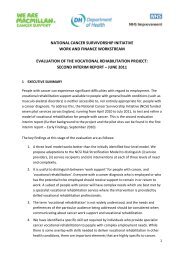
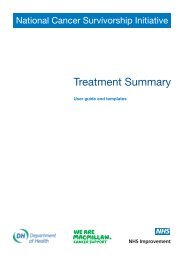

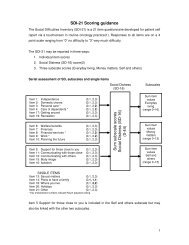

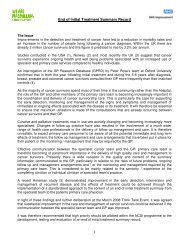
![Download the how to guide [PDF] - Macmillan Cancer Support](https://img.yumpu.com/47067428/1/184x260/download-the-how-to-guide-pdf-macmillan-cancer-support.jpg?quality=85)
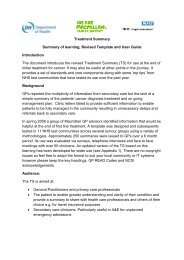

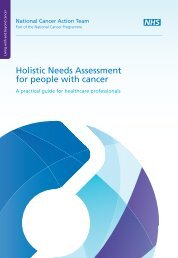
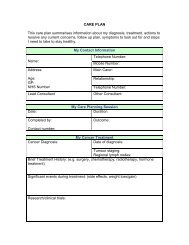

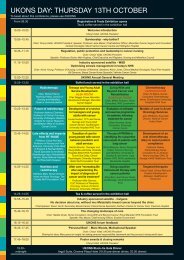
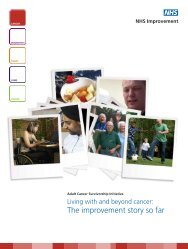
![HOPE Protocol [PDF, 420KB] - National Cancer Survivorship Initiative](https://img.yumpu.com/32566432/1/184x260/hope-protocol-pdf-420kb-national-cancer-survivorship-initiative.jpg?quality=85)